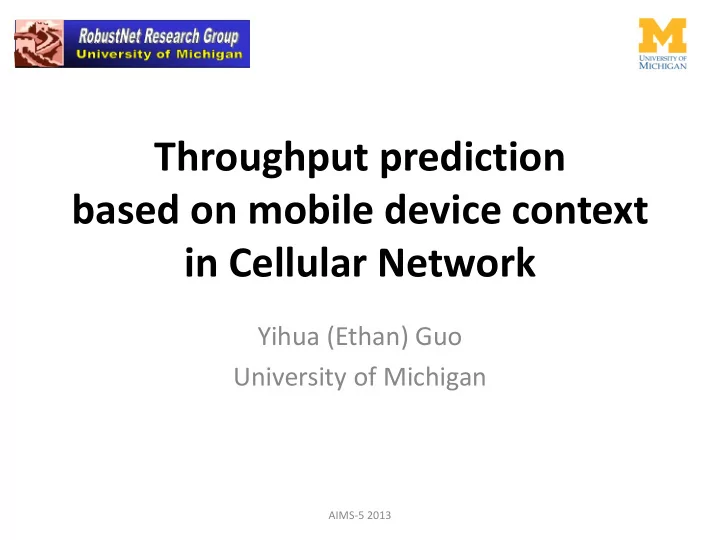

Throughput prediction based on mobile device context in Cellular Network Yihua (Ethan) Guo University of Michigan AIMS-5 2013
Background • Prevalence of cellular networks – Mobile Traffic is expected to grow rapidly in the near future [Cisco VNI White Paper] – 4G LTE network with much higher bandwidth (100 Mbps downlink and 50 Mbps uplink) and lower RTT (<5ms user- plane latency) [3GPP TR 25.913] – Several measurement tools targeting at cellular network performance Yihua Guo AIMS-5 2013 2
Challenges • How can mobile devices better utilize the cellular network resources? Bartendr ARO IMP SALSA DWRA Our Approach Layer A A/T A A T A/T Scheduling? Use context net Location RRC net type, RTT RSSI, RRC state RSSI state type RSSI Efficient context? Different network? Throughput prediction? T: transport layer, A: application layer Yihua Guo AIMS-5 2013 3
Challenges • How can we better predict performance? – It’s dynamic, yet depending on the context – Data analysis: correlating performance (e.g. TCP throughput) with device context – Accuracy and overhead of prediction Yihua Guo AIMS-5 2013 4
Utilizing the Mobile Device Context • Radio Access – Network type, signal strength , cell ID, RRC/DRX state, etc. • Sensors – Acceleration, GPS coordinates, etc. • Other – Device type, screen on/off, time of day, etc. Yihua Guo AIMS-5 2013 5
Measurement Settings • Methodology – Mobile Device: Android (with access to a nation-wide ISP) – TCP connection with continuous randomized data transfer in 2-5 minutes. Phone is kept stationary during the data transfer. – Skip the first 10 seconds without sampling – Throughput is sampled every 500 ms, device context is collected at the same time, packet traces are collected from both device and server – Downlink : server -> device, Uplink : device -> server – Different areas / network types / devices are considered Yihua Guo AIMS-5 2013 6
HSDPA Downlink r = 0.6141 Yihua Guo AIMS-5 2013 7
HSDPA Uplink r = -0.0098 Yihua Guo AIMS-5 2013 8
LTE Downlink r = 0.8475 Yihua Guo AIMS-5 2013 9
LTE Downlink r = 0.4814 Yihua Guo AIMS-5 2013 10
LTE Uplink r = 0.6738 Yihua Guo AIMS-5 2013 11
TCP Slow Start (LTE Downlink) Yihua Guo AIMS-5 2013 13
TCP Slow Start (HSDPA Downlink) Yihua Guo AIMS-5 2013 14
Implications • Findings – HSDPA/LTE Downlink, LTE Uplink: positive correlation – HSDPA Uplink: nearly no correlation – TCP slow start period for LTE can be long • How can we make use of the results? – Signal strength is a factor that affects LTE performance – May need additional information to improve the prediction (more fine-grained) Yihua Guo AIMS-5 2013 15
Implications • How can we make use of the results? (cont’d) – Measurement fails if the bottleneck is not the cellular network part, or TCP connection does not saturate the link – Data consumption could be high for a single throughput test ( > 35MB for ~ 30Mbps, 10 s ) 1 Measured Throughput (kbps) 40000 35000 0.8 30000 CDF 25000 0.6 20000 0.5 15000 0.4 35299.62 10000 5000 kbps 0.2 0 0 0 20000 40000 60000 Measured Throughput (kbps) Yihua Guo AIMS-5 2013 16
Data Sharing • Working on this • Privacy is the main concern – Sensitive information: IMEI, location, phone type, carrier, timestamp Yihua Guo AIMS-5 2013 17
Discussions • The effectiveness of throughput prediction in cellular network • Validation on methodology of bandwidth/throughput measurement (to be coherent between datasets) • Management and analysis of measurement data Yihua Guo AIMS-5 2013 18
Thank you! AIMS-5 2013
Recommend
More recommend